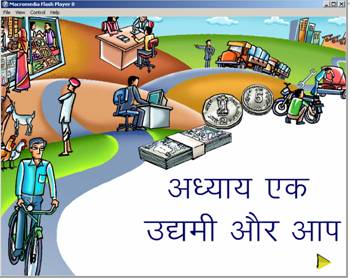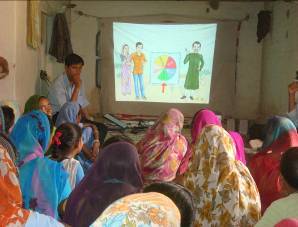|
Rural Entrepreneurship
Development
and
Literacy Programme
– An Inclusive Approach
The
objective of the Entrepreneurship Development Programme (EDP) is to
motivate rural persons, especially the youth and women towards
entrepreneurship, develop their business understanding and skills and
empower them to independently establish and manage successful
enterprises. It covers the basics of enterprise identification, setting
up and managing businesses to meet the needs of aspirants as well as
existing entrepreneurs.

EDP, an ICT product, has been developed using Adobe Flash; the training
is delivered through a multimedia platform. It delivers its objectives
using interactive graphics, animations and videos wherein the content of
training programme is divided into chapters and modules. All these
efforts and visuals ensure that an illiterate person can also learn the
level of business without any difficulty in understanding the same. The
delivery mechanism is facilitated by well-trained trainers cum mentors
whose job is to ensure the simplification of the contents and deployment
of participative exercises.
The trainees are helped to identify, assess and shape their personality
traits into a suitable enterprise solution. This ensures that the
resultant enterprises are long-term solutions based on their
personalities instead of short-term forced solutions based on someone
else’s perceptions.
The contents and objectives of Enterprise Development Programme are:
• Introducing the fundamentals of business and nurturing a sense of
entrepreneurship among the trainees
• Identifying the different stepping stones for any enterprise setup and
the possible ways to manage the challenges
• Analysing market opportunities, and understanding the competition and
the resources (market survey)
• Calculating the costs and investments for converting the business idea
to reality (start up cost, working capital, marketing expenditures)
• Managing book keeping and accounting and identifying the different
government schemes that can help the entrepreneurs mobilise their
financial resources
• Introducing the learners to the legal obligations and formalities
required to be completed for starting any enterprise
• Developing the confidence and language skills by means of
participative discussions and games to help learners face competition
• Imparting motivational thrust ‘Yes, you can do!’
TARA Akshar
TARA Akshar is a computer-based functional literacy program which
teaches completely illiterate people to learn read and write Hindi
(Devanagri) in 30 days.
This programme trains the student to instantly recognise the sound of
the letter without hesitation, followed by combined letters (syllables),
and then let the students loose on words and sentences. In the TARA
Akshar program, the student does not have to TRY to memorise anything;
rather, he/she simply watches and plays and the memorising takes care of
itself.
The Inclusive
Approach: Literacy and Entrepreneurship Together
In the last couple of years, the Indian economy has grown at a
phenomenal rate of over 9% per annum. Millions of Indians - who are
educated and constitute the middle class - have benefited from this
growth. However, an equally large segment of India’s population is
either unemployed or not in a position to participate in this growth
process and share the benefits just because it is illiterate.
Even after 60 years of independence, India is home to the largest number
of illiterates and unemployed on earth. A whopping 400 million are still
illiterate. Illiteracy is one of the major causes of socio-economic
conflict. Poverty, unemployment and underdevelopment are the associated
ills of illiteracy.
Literacy forms the cornerstone for providing equality of opportunity. It
leads to increased self-confidence, self-esteem and awareness levels. It
allows people, especially women, to participate much more effectively in
the development process. For women, it helps tremendously in increasing
their status in the family as well as in the society and also leads to
gender equity.
Unemployment is an equally serious problem for individuals, especially
women from poor families who tend to have little or no education. The
consequence is unemployment or low productivity jobs with very little
pay, keeping them and their families trapped in the vicious cycle of
poverty. According to a study, 15 million jobs are required outside the
agriculture and government sectors in India every year. This immense
economic need has a huge negative impact on society. Unsustainable
consumption practices also lead to rapid depletion of natural resources.
Both the Government of India and several NGOs have been focusing on
literacy and rural entrepreneurship as a key route to solving the need
for economic and social empowerment. But the major limitation of the
existing programmes is the availability of only one part of the
solution, which is either a literacy programme or a rural
entrepreneurship programme. Additionally, most of the literacy
programmes are ineffective and too long in duration, and most of the
entrepreneurship programmes lack facilitation of meaningful and viable
enterprise options and the inadequacy of market, technical and financial
linkages. Most importantly, the need for capacity building supports an
enterprises’ life cycle, a facility that is largely nonexistent.
Without any concerted action, illiteracy and unemployment can impede
growth and development of the country. TARAhaat, the ICT arm of
Development Alternatives (DA), delivers TARA Akshar and TARA Livelihood
Academy (TLA), a livelihood arm of DA delivers a rural entrepreneurship
programme called Enterprise Development Programme (EDP).

In the first phase for inclusive intervention, the EDP has been
customised for Self Help Groups (SHG). In an attempt to customise the
EDP, several field trials have been made. The customisation exercise was
full of teachings and new findings about SHG expectations regarding
enterprise development. Adding to this, the most vibrant outcome of the
test and experiment is the effective inclusion of two different contents
together. A total of 100 women from different groups have witnessed and
benefited by the inclusive intervention of TARA Akshar and the EDP. The
EDP programme has been imparted to the same 100 SHG women who have been
trained by TARA Akshar in Prithvipur village of Tikamgarh district in
Madhya Pradesh. The exercise has given the learning framework and laid
the foundation for a ‘demand-driven community product’.
Exercise and
Learnings – EDP Customisation for SHGs
A hundred SHG participants have been trained in four different batches,
each batch constituting 25 members. The training duration was of seven
days with four hours’ sessions every day. The learnings have been
incorporated in the product.
• Since many business terms were completely new to SHGs, a dedicated
vocabulary chapter on enterprise and livelihood has been introduced.
Through illustration and animation, the value chain and the life cycle
of any enterprise can be easily briefed to the participants
• The texts’ appearance on Flash has been changed. Since most of the
women were either illiterate or faced difficulties while reading, most
the time the screen scenes get changed before they were able to complete
reading of the text displayed on the screen .The students first
recognise alphabets, pronounce them, combine them and then read the text
matter. It was also found that the women first listened to the audio
voice and then tried to discover where the said alphabet lies on the
screen. Considering these learnings, the text appearance has been
corrected by introducing alphabet occurrence unlike the sentence
occurrence in previous EDPs. Adding to this, there was a substantial
pause and time gap in the audio so that women can easily recognise and
listen to the voice. A new inside slide bar control is also introduced
in the customised EDP so that the facilitator can easily move around
scenes to explain them to the trainees
• Since the audience of product is SHG and CIG, a very participative
script has been used in the customised EDP so that participants feel
active and entertained while being trained. The need was also felt to
introduce completely new characters in the new product; three new
characters representing SHGs have been introduced. All these three
characters are women and their social economical condition has been
portrayed just like any general village level women so that the
participants can better correlate themselves with the character.
• During the Focused Group Discussion (FGD) with parti-cipants, it has
been asked whether they prefer female facilitators over male trainers.
The outcome of this discussion was unexpected; almost 80% SHG
participants preferred a male facilitator. This feedback has given us
the outline to structure the lead character ‘TARAguru’, who acts as an
enterprise guru in the customised EDP. Initially, the design team was
expecting the lead role to be a female character; after the FGD, the
participants made it clear that the TARAguru should be a male character
and, when tested, it worked!
• The visuals and illustrations used in the customised product have been
given a completely new look. Since the learnings from earlier field
trials has given strong inputs on the dress sense of the characters,
word selection over texts, background and, more particularly, the
simplification of examples were some of the critical areas where
correction has been carried out
• It has been found that EDP can better demonstrate its capacity to the
TARA Akshar trained participants since TARA Akshar outlines two major
benefits – one is the source to make literate participants who can
better understand and participate in the EDP training programme and
another is their exposure to the ICT domain. When the impact and
learning is compared in the scale of TARA Akshar-trained participants
and non TARA Akshar-trained participants, it is evident that EDP, when
delivered along with TARA Akshar, has much better impact
• In order to start training on the time and ensure that all
participants should arrive at the right time, video songs were played at
the very beginning of the session. It was observed that participants
were very keen to be a part of video right from the beginning;
therefore, they used to come on time when the video was about to start.
The exercise was appreciated by almost 99% participants even though some
of them owned TV sets at home. What they liked in this initiative was
‘watching the video in company and being able to express their opinion
on the dresses, ornaments, homes, etc. This gave the women a glimpse of
freedom and independency. This initiative received a huge response from
the participants. It was also utilised to give the women greater
flexibility and opportunity to listen, recognise, understand and
practice the reading exercises by putting a marquee of lyrics on the
bottom of the videos so that participants can also read what is being
displayed. Participants were also encouraged by their facilitators; this
exercise gives the participants more flexibility to interact with their
facilitators as also other members
• A small batch size is better. It has been realised that participants
in groups of 16-20 are best trained
• The training duration which was originally for seven days for four
hours per day is not feasible. Since the participants are women with
domestic liability, taking out four hours per day was highly
impractical. Thus, it was realised that training sessions should be
customised vis-à-vis understanding the interests of SHG to 12 days with
two hours every day
The EDP has substantially proved its worth as a potential content that
can be widely delivered for enterprise development activities.
Other Initiatives
DA has been recognised as a Micro Enterprise Development Centre (MEDC)
by Hewlett Packard. There are 13 total such centres across India. The
responsibility of MEDC is to encourage entrepreneurship activities among
possible stakeholders and mentor local institutions and organisations
regarding managing enterprise development programmes. The TARA
Livelihood Academy has been authorised to deliver a HP enterprise
development curriculum called Smart Technology for Smart Business
(STSB).
q
Praveen Manikpuri
pmanikpuri@tarahat.com
Back to Contents
|

